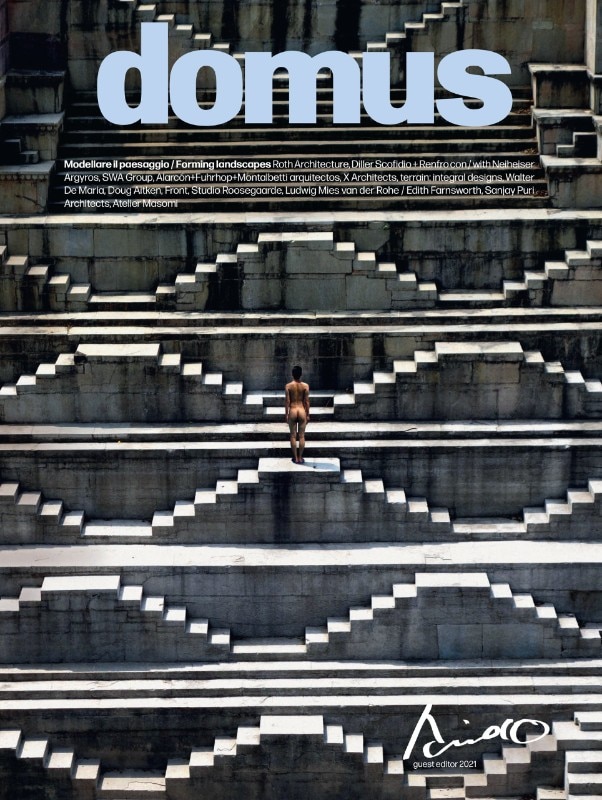The May issue focuses on the role of landscape architecture in the world of the future, the new challenges dictated by changing natural environments and the need to develop new methods in step with the times. Domus 1057 opens with three essays: guest editor Tadao Ando stresses “the importance of the coexistence of nature and the urban environment”; Jordi Bellmunt Chiva draws up a list of the challenges of the “new landscape architecture”; Tomoki Kato takes us on a journey through Japanese gardens and their relationship with the cities to which they belong.
The Architecture section presents six projects, divided into three interconnected themes: integrating landscape, intervening in landscape, and generating landscapes. In Qintana-Roo, Mexico, a museum is not born from a predefined idea but is modeled on the fluidity of nature itself, thanks to the collaboration between Roth Architecture and local artisans. On the banks of the Thames, Diller Scofidio + Renfro and Neiheiser Argyros, create an elevated park modeled with respect for native vegetation and devoid of unnecessary structural complexity. A scenic trail in Shenzhen, China, allows visitors to enjoy an elevated viewpoint over the forest, “achieving a balance between environmental sensitivity and iconicity.” In Chile, a memorial created by Alarcón+Fuhrhop+Montalbetti arquitectos, exploits the contrast between fifty concrete slabs and uncontaminated nature to convey the elaboration of mourning without constraints or prejudices. Finally, two landscapes generated by the need to restore the local ecosystem in the United Arab Emirates and Austria show us how landscape architecture uses natural dynamics and climate to create an environment “inextricably linked to the health and vitality of our planet.”
In the Art section, Doug Aitken and Walter De Maria formulate a new paradigm of Land Art, from an anthropocentric approach towards an ecocentric one, sensitive to the change of time.
Design by Nature, on the other hand, is a project somewhere between art and design that opens the Design section. It develops objects inspired and modelled on the forms of the natural environment, thanks to the collaboration and creativity of Patrizia Moroso. Furthermore in the Design section we find the project Urban Sun by Studio Roosegaarde, born and accelerated by the pandemic, on how “the power of light can be used to fight viruses and improve our well-being”.
In the Creators section, we asked illustrious names including John Pawson, Paul Smith, Tatiana Bilbao, Jean Nouvel and Thomas Heatherwick how to create the landscape. The answer came in the form of images, sketches and texts, an exceptional expression of creativity between architecture, design and photography.
The column Around the Project opens with the story of the relationship between Mies Van der Rohe and his client Edith Farnsworth, stormy and unusual yet from which the Farnsworth House, a masterpiece of Modernism, was born. Followed by the construction challenge of the Prestige University in India, a building that spans on 8,000 square meters of irregular terraces but only 20 meters in height.
Closing up, a visit to Atelier Masomi of Mariam Kamara, who has developed a dynamic, real-time remote work system to meet the challenges dictated by the pandemic but also by the duality of the studio, which is divided between projects in Africa and the United States.

In this month's Diary: at the Round Table with Francesca Condò, Giovanna Borasi, Federico Palazzari and Roberto Cremascoli we discuss how the pandemic will change the role and spaces of museums. With Carlos D'Ercole, we enter the home of Terry Winters in New York, among pieces of African craftsmanship and iconic designs. Art historian Valentina Petrucci recounts the close link between Dior's fashion and art. Stefano Maffei exposes the “other voices”: emerging designers and their relationship with an industry in continuous evolution.
These are followed by pages dedicated to innovation in stores and children's toys. The talent of Gereon Wahle and his hybrid design emerges. We look at design objects, from Scavolini to Nordic designs, and conclude with an interview by Domus editor Walter Mariotti to Federico Faggin, the inventor of the microprocessor and the touch screen, on the potential of Milan and the future of technology.




















